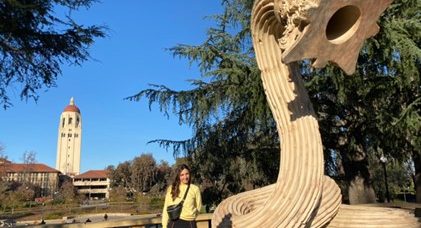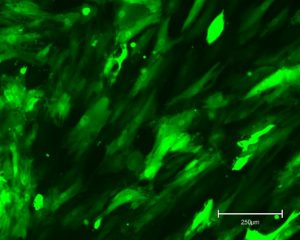
8 April 2022
Ageing is associated with the accumulation of epigenetic changes to a cell’s DNA. Attempts to slow or even reverse ageing understandably attract a lot of attention, and one novel strategy of particular interest is attempting to ‘rejuvenate’ existing cells. With the help of a Travelling Fellowship, PhD student Priscila Chiavellini was able to visit Stanford University to investigate this approach.
It has previously been shown that expression of the genes Oct4, Sox2, Klf4 and c-Myc (otherwise known as the OSKM genes) in cultured mouse fibroblasts can induce pluripotency. In other words, the fibroblasts are reprogrammed to become stem cell-like, meaning that they acquire the potential to be differentiated into a range of different cell types. Stem cells produced in this way have come to be known as induced pluripotent stem cells, or iPSCs.
It is possible to skip this iPSC stage by transiently expressing the OSKM genes and adding appropriate differentiation factors. This is sometimes called ‘partial reprogramming’. A study in 2016 showed that this transient expression of the OSKM genes can also remove some epigenetic age markers, while the markers that define the cell’s identity (as a fibroblast, a muscle cell, or a neuron, say) remain unaffected. However, this study was carried out in a mouse model of premature ageing, so it was unclear how partial reprogramming might affect natural ageing in human cells. Dr Vittorio Sebastiano’s group at Stanford University addressed this issue, demonstrating that markers of cell age could be removed from human fibroblasts and endothelial cells (without erasing markers of cell identity) by transient expression of the OSKM genes, plus Lin28 and NANOG.
Meanwhile, Priscila and her colleagues at Instituto de Investigaciones Bioquímicas de La Plata, Argentina, had constructed an adenovector that drives transient expression of the OSKM genes alongside a GFP reporter. To determine the effectiveness of this adenoviral strategy in reprogramming human cells, Priscila used a Travelling Fellowship from Development to visit Dr Sebastiano’s lab at the end of 2021.

In Stanford, Priscila set to work transducing cells with her adenovector. The GFP reporter allowed her to sort cells that had been successfully transfected from those which had not; the non-transfected cells would act as a useful control group. She then compared hallmarks of cell age, such as histones H3K9me3 and H2Ax, between the two groups of cells. She also collaborated with Steve Horvath’s lab, who specialise in the analysis of epigenetic markers of cell age. The results have proven important for Priscila’s thesis, since they show promise for using the adenovector to induce cellular rejuvenation.
Priscila’s trip had been delayed several times due to the ongoing coronavirus pandemic, so she was delighted to finally be able to make the journey. The success of her visit has kickstarted a fruitful collaboration with the Sebastiano lab and has had a profound effect on her career. “This experience made me grow not only in a professional but also in a personal aspect,” she said. “I met very friendly and smart people, we shared thoughts and great moments too. I felt pushed to broaden my knowledge and my mind, and this will enable me to do better research”.








You must be logged in to post a comment.